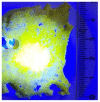The Optimization of Radiation Synthesis Modes for YAG:Ce Ceramics
- PMID: 37109993
- PMCID: PMC10142568
- DOI: 10.3390/ma16083158
The Optimization of Radiation Synthesis Modes for YAG:Ce Ceramics
Abstract
Synthesis in the radiation field is a promising direction for the development of materials transformation processes, especially those differing in melting temperature. It has been established that the synthesis of yttrium-aluminum ceramics from yttrium oxides and aluminum metals in the region of a powerful high-energy electron flux is realized in 1 s, without any manifestations that facilitate synthesis, with high productivity. It is assumed that the high rate and efficiency of synthesis are due to processes that are realized with the formation of radicals, short-lived defects formed during the decay of electronic excitations. This article presents descriptions of the energy-transferring processes of an electron stream with energies of 1.4, 2.0, and 2.5 MeV to the initial radiation (mixture) for the production of YAG:Ce ceramics. YAG:Ce (Y3Al5O12:Ce) ceramics samples in the field of electron flux of different energies and power densities were synthesized. The results of a study of the dependence of the morphology, crystal structure, and luminescence properties of the resulting ceramics on the synthesis modes, electron energy, and electron flux power are presented.
Keywords: YAG:Ce ceramics; energy loss; high-power electron flux; luminescence; structure; synthesis.
Conflict of interest statement
The authors declare no conflict of interest.
Figures











References
-
- Xiao Z., Yu S., Li Y., Ruan S., Kong L.B., Huang Q., Huang Z., Zhou K., Su H., Yao Z., et al. Materials Development and Potential Applications of Transparent Ceramics: A Review. Mater. Sci. Eng. R Rep. 2020;139:100518. doi: 10.1016/j.mser.2019.100518. - DOI
-
- Smet P., Parmentier A., Poelman D. Selecting Conversion Phosphors for White Light-Emtting Diodes. J. Electrochem. Soc. 2011;158:R37–R54. doi: 10.1149/1.3568524. - DOI
-
- Ye S., Xiao F., Pan Y.X., Ma Y.Y., Zhang Q.Y. Phosphors in Phosphor-Converted White Light-Emitting Diodes: Recent Advances in Materials, Techniques and Properties. Mater. Sci. Eng. R Rep. 2010;71:1–34. doi: 10.1016/j.mser.2010.07.001. - DOI
-
- Pan Y., Wu M., Su Q. Comparative Investigation on Synthesis and Photoluminescence of YAG:Ce Phosphor. Mater. Sci. Eng. B. 2004;106:251. doi: 10.1016/j.mseb.2003.09.031. - DOI
Grants and funding
LinkOut - more resources
Full Text Sources

